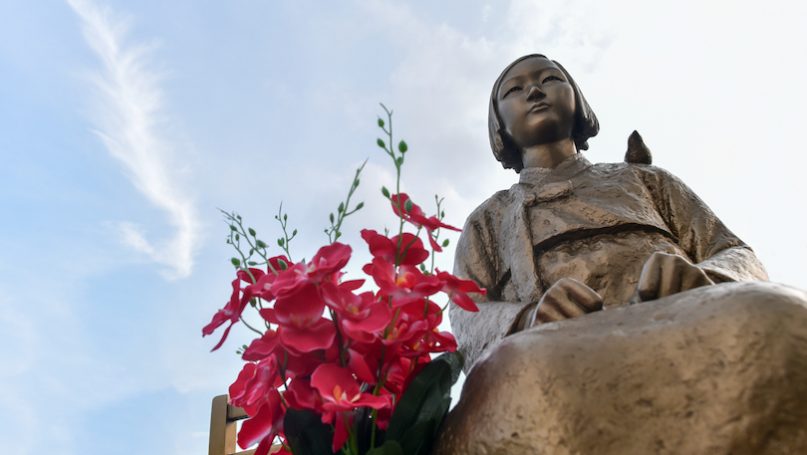
This is an excerpt from Park Statue Politics: World War II Comfort Women Memorials in the United States. Get your free copy here.
Since beginning our research on this topic in 2014, our work on this book has taken us to Japan, Korea, Taiwan, and across the United States. It has led us to conclude that in most cases the comfort women were deceptively recruited, and in some cases they were abducted. They were sexually violated and suffered unimaginable physical and psychological abuse. Sadly, the chapters that followed in their lives were largely defined by these experiences.
Our research has led us to conclude that the main actors responsible for this are the Japanese militarists who implemented and subsequently concealed the system, exploiting the women they coerced to staff it. Yet responsibility does not lie with the Japanese alone. It also lies with the Koreans, Taiwanese, and Chinese who benefited by recruiting for or managing the comfort women system. It also lies with those who, like the non-German supporters of Nazism, supported the Asian Co-Prosperity Sphere that required militarization and other “sacrifices” to defeat Western colonialism and replace it with Japan’s own empire.
Fault also lies with the American occupation leaders who downplayed and dismissed evidence of the system, assented to the United States military’s 1945-46 use of comfort women, and permit the still ongoing use of camp town brothels where young Asian women have served as prostitutes for GIs and sex tourists for the past eight decades.
The U.S. monuments memorializing the suffering of the WWII comfort women do not address the broader penumbra of culpability related to the comfort women system. They only indicate Japan’s culpability. They do not address the misogynist mindset that enabled the system. They make no mention of the major role played by Korean and Taiwanese collaborators who deceptively recruited the young female victims, promising them education and professional development rather than the fate that actually awaited these women.
The statues also make no mention of America’s role in perpetuating the comfort women system following WWII. The cities establishing the memorials fail to take into account how the alliance among Japan, Korea, and the United States is affected by creating anti-Japan memorials that attribute culpability to a single source, while in reality numerous Koreans, Chinese, and Americans also hold responsibility for the abuse of Asian women during and following the war.
The sexual and psychological abuse that women suffered due to the comfort women system constituted an egregious violation of human rights. However, American monuments recollecting this tragic chapter of history need to tell a more complete and honest story than what we find in places such as Fairfax, Virginia, Palisades Park, New Jersey, and Glendale, California, which only focus on Japan. Just as Germany had its non-German “Ivans” who tortured and killed the victims in the death camps, Japan’s militarists had their share of supporters who were neither Japanese in nationality nor in ethnicity but who deceived, coerced, and abused the victims of the comfort women system.
Koreans should not downplay the major role that Korean agents played in recruiting the victims and in helping to manage them, and Americans should recognize their role in the prolongation and patronization of the comfort women system and the cover-up that prevented prosecution of the guilty parties.
The decision not to prosecute those responsible for the comfort women system was made by U.S.-led occupation forces at the end of WWII, and the U.S. military’s patronage of the vast, exploitative network of prostitution in Japan, Korea, and the Philippines which began after WWII continues to this day.
China is also implicated. Thousands of young Korean women are deceptively promised refuge from the suffering of North Korea and travel to China only to be forced into a modern comfort women system where they are sold as brides or find themselves forced to work in brothels for years to pay the debt incurred to China-based trafficking rings. These women serve as indentured sex workers and face miserable lives and endless humiliation.
The broader context of events that we mention here needs to be taken into consideration when the comfort women question is examined outside of Japan and Korea.
We believe that the acceptance and acknowledgement of the materials presented in this book will encourage introspection; it will hopefully inspire thoughtful initiatives to address the longstanding cultural assumptions and institutions in Asia and America alike that have demeaned women and contributed to their victimization in the past as well as in the present. The time has come to address these attitudes, rather than allow this historical tragedy to be used by reckless nationalists and self-serving politicians be they Japanese, Korean, Chinese or American.